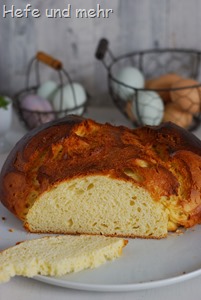 Petras comment here made me thinking about baking this years Easter pinze with sweet starter. I already had a spelt variant in my mind and so I decided to combine both ideas. To keep the pinze moist, I replace the milk with some cream and reduced the amount of butter. Cream has not only a positive effect on the crumb, it is although good if you plan to let the pinze rise over night in the fridge, as the cream will not harden in the cold as butter would do. So the Easter Pinze can rise unaffected and it is easy to serve a oven fresh bread for easter breakfast.
Petras comment here made me thinking about baking this years Easter pinze with sweet starter. I already had a spelt variant in my mind and so I decided to combine both ideas. To keep the pinze moist, I replace the milk with some cream and reduced the amount of butter. Cream has not only a positive effect on the crumb, it is although good if you plan to let the pinze rise over night in the fridge, as the cream will not harden in the cold as butter would do. So the Easter Pinze can rise unaffected and it is easy to serve a oven fresh bread for easter breakfast.
As the dough contains a bit more fat (from the cream) I added some more egg yolk, too. This adds a nice yellow hue to crust and crumb, which is very nice especially on rainy Easter Sundays like it was this year. The pale green eggs in the background of the pictures are from my uncles hens, which belong to the so called “Easter eggers”, a variety of chicken which carries a special gen for a blue to green stained egg shell. So I get a perfect green Easter egg without staining 🙂
Spelt Easter Pinze
Sweet Starter 
- 100g Spelt flour Type 630
- 100g sweet Starter
- 50g Water
Preferment
- Sweet Starter
- 120g Spelt flour Type 630
- 50g egg yolks (4 egg yolks)
- 55g Ei (1 Egg)
- 35g Sugar
water roux
- 30g Spelt flour Type 630
- 150g cream
Dough
- Prefermnt
- water roux
- 255g Spelt flour Type 630
- 35g sugar
- 70g Milk
- 55g Butter
- 5g Salt
- zest of 1 Lemon
Glazing
- 1 Egg, stirred
Mix all ingredients for the Sweet starter and let it rise for 3 hours at 30°C. (You can do this the day before as well. Store the sweet starter in the fridge until the next morning)
For the water roux whisk water and flour until lump free, then heat it up to 65°C (needs about 3 min) while whisking. Fill the water roux in a bowl, cover its surface with cling foil and let it cool down to room temperature.
For the preferment, mix all ingredients and let it rise for 3 hours at 30°C.
In a stand mixer mix the preferment and milk roux with flour, salt, lemon peel and milk and knead for 5 min at slow speed, then another 2 min until medium gluten development.
Now turn the mixer to slow speed then add the sugar, knead for another minute. Now add the butter all at once and knead until full gluten development (about 5 min).
Ferment for 1.5 hours.
Form dough into a ball.
Proof for 1.5 hour at room temperature or over night in the fridge.
After proofing glaze with egg or cream. Now cut the loaf with scissors tree times at the sides, the cuts should meet in the middle.
Bake at 180°C for about 40 min with steam.
Deutsch



perfektes rezept, wenn man dinkelliebhaber in der familie hat – dankeschön!! eine frage hätte ich: wenn ich die stockgare über Nacht im kühlschrank mache, mit welcher zeit muss ich dann ungefähr für die stückgare bei raumtemperatur rechnen? liebe grüße!
@M: Da ist mir dein Kommentar doch fast durchgerutscht, entschuldige: Bei der Stückgare würde ich mit 30-45 min mehr rechnen. 🙂
oje, und mir Ihre antwort – daher erst jetzt ein verspätetes, aber herzliches dankeschön!
Es ist zwar nicht “Ostern” aber so etwas kann man immer essen, Hauptsache mit Dinkel 😉
Oben schreibst du: “30g Dinkelmehl Type 630 und 150g Sahne”
Unten dann: “Für das Kochstück Mehl und Milch Klümpchenfrei verrühren…”
Nimmt man nun Sahne oder Milch, – ist ja doch ein großer Unterschied, oder?
LG
@Brigitte: Da war in der Beschreibung ein Fehler, danke fürs Aufmerksam-machen! Ich habe es korrigiert, jetzt steht beides Mal da auch Sahne 🙂
Kennst du den Tag weizenfrei schon? Darunter findest du alle Rezepte, die ohne Weizenmehl daher kommen!
Zu schade, dass ich mich schon für das andere Rezept entschieden hatte. Meinst du die Pinzen funktionieren auch mit Lievito Madre?
@Eva: Wenn deine Madre nicht zum säuern neigt, dann geht das auf jeden Fall – die beiden sind sich ja sehr ähnlich. Ich würde sie aber auch warm führen.
Liebe Stefanie, gerade sitze ich und geniese dabei deine Sahnebrioche, und was sehe ich noch ein leckeres Rezept, wird nächste Woche nachgebacken, ohne jeglichen anlass.
Sieht richtig gut aus und die schöne lockere Krume beeindruckt mich. Kommt mal auf die Nachbackliste,
wenn auch erst für das nächste Jahr, aber egal. Vielleicht klappt es auch früher…
Lg Dagmar
und noch einen schönen Ostermontag
Liebe Stefanie, ich hab auch noch ein bisschen mit dem süßen Starter und der Pinze herumprobiert. Ist auch essbar gewesen, aber dann war die Optik nicht so gut – zu flach. Werde nächstes Jahr weiter probieren. Für heuer hab ich genug von der Pinze😂. Jetzt kann ich mich ja ein wenig an deinem Dinkel Rezept orientieren.
Danke für den Link zu meiner Seite. Wünsch dir noch einen schönen Ostermontag.